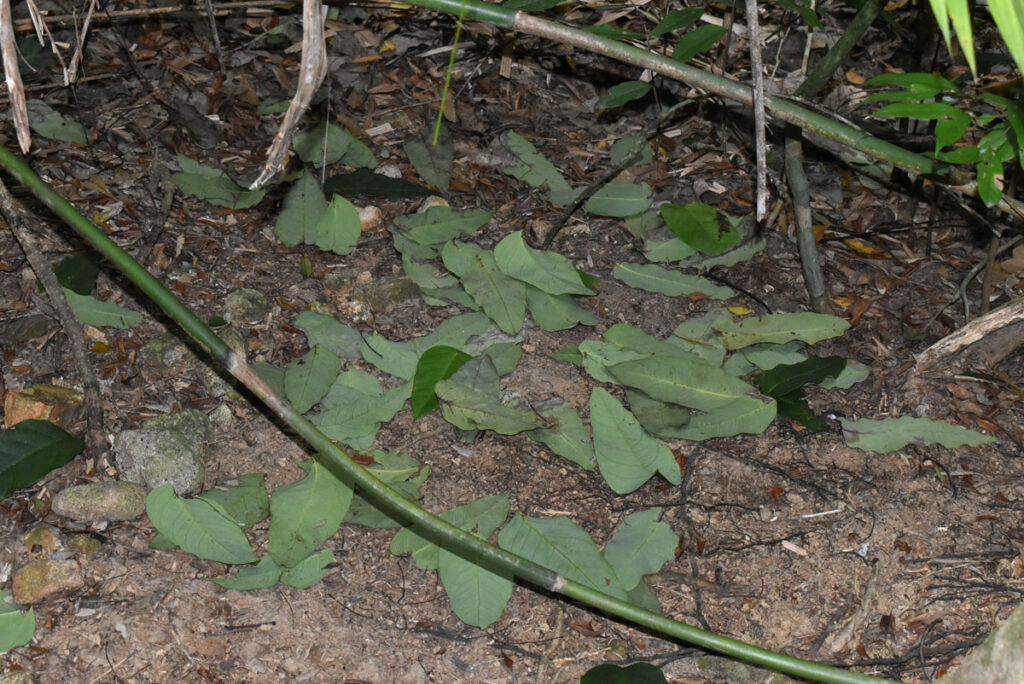Earlier this month, the forest around Paluma began to ring out with the sounds of a bird that is better known for its distinctive courting area than its plumage or its song. The Tooth-billed Bowerbird or Stagemaker (Scenopoeetes dentirostris) has a noisy and boisterous call although it’s not as distinctive to a casual observer as the circular patch of leaves that it carefully lays out on a patch of forest floor to attract females. This “Stage” is familiar to most people who walk the village trails. One of us (PC) was able to record a particularly vocal individual near Mt Spec Rd.

The Stagemaker is endemic to highland rainforests of the wet tropics, and is the only member of the genus Scenopoeetes. While it is common within its range its restricted distribution and dependence on highland rainforest means it is considered near threatened on the IUCN list of Threatened Species.
During the winter months, it feeds mainly on leaves and stems. This is an unusual diet for an arboreal bird. Only 3% of bird species eat leaves, which are not very energy-dense, and require large volumes of material to satisfy their energy needs. The toothed profile of the bill (from which its common name is derived) is believed to be an adaptation for cutting leaves and stems (for both food and stage displays. During the mating and breeding season when more energy is needed for display, defending stages, egg production and feeding of young, Stagemakers switch to a diet of fruit and flowers, supplemented with insects.


Stage production, display and nesting commence with the onset of fleshy fruit production (August to September) and displays stop with the onset of the wet. The stage, or court is first cleared of leaf litter by the male and then decorated with leaves from a few species of tree, which are all carefully turned so the paler underside is facing upward. The stage is carefully maintained by the male to ensure the leaves are properly orientated. Stages are clustered in an area with stages separated by 50-68m. Males are long-lived and return to clear the same stage every year (over 20 years in one case). Adjacent males compete for suitable leaves and will steal from the stages of other birds.
Each court has an adjacent display tree the male uses to announce its presence. Its song can include mimicry of over 40 bird species, frogs, and even fruitbats! The recording above appears to be the native call rather than a mimic. Once a female has been attracted to the stage, the male descends from its perch to display and entice the female into mating. The female builds a nest in a tree nearby and appears to rear the young unassisted.
Stagemakers are currently considered to be Bowerbirds, but the lack of a true bower constructed from twigs, and the lack of different plumage between males and females led some taxonomists to initially place these birds with the closely related catbirds (Genus Ailuroedus) within the overarching Family (Ptilonorhynchidae). More recent genetic research suggests that the Stagemaker is a distant relative of the maypole building bowerbirds (e.g. our local Golden Bowerbird), but it has traits that suggest it might have evolved separately from both groups, or a primitive form of catbird.
Much of what we know about the ecology and biology of the Tooth-billed Bowerbird has come from research conducted around Paluma. The preponderance of these studies were carried out by Cliff and Dawn Frith, who lived in Paluma and have published both scientific as well as gorgeously illustrated popular books on Bowlerbirds, Birds of Paradise and general rainforest natural history.
Text by Jamie Oliver ; Photos as indicated
